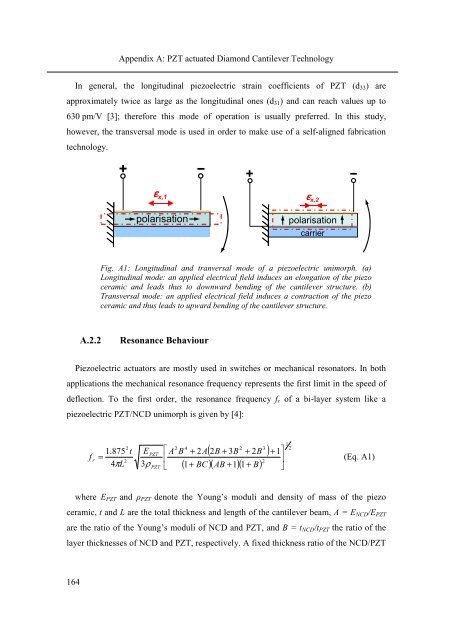PhD Thesis Arne Lüker final version V4 - Cranfield University
PhD Thesis Arne Lüker final version V4 - Cranfield University
PhD Thesis Arne Lüker final version V4 - Cranfield University
You also want an ePaper? Increase the reach of your titles
YUMPU automatically turns print PDFs into web optimized ePapers that Google loves.
164<br />
Appendix A: PZT actuated Diamond Cantilever Technology<br />
In general, the longitudinal piezoelectric strain coefficients of PZT (d33) are<br />
approximately twice as large as the longitudinal ones (d31) and can reach values up to<br />
630 pm/V [3]; therefore this mode of operation is usually preferred. In this study,<br />
however, the transversal mode is used in order to make use of a self-aligned fabrication<br />
technology.<br />
A.2.2 Resonance Behaviour<br />
Piezoelectric actuators are mostly used in switches or mechanical resonators. In both<br />
applications the mechanical resonance frequency represents the first limit in the speed of<br />
deflection. To the first order, the resonance frequency fr of a bi-layer system like a<br />
piezoelectric PZT/NCD unimorph is given by [4]:<br />
f<br />
r<br />
2<br />
1.<br />
875 t<br />
= 2<br />
4πL<br />
+ −<br />
E<br />
3ρ<br />
εεεε x,1<br />
polarisation<br />
PZT<br />
PZT<br />
⎡ A<br />
⎢<br />
⎣<br />
2<br />
B<br />
4<br />
+ 2A<br />
2 3<br />
( 2B<br />
+ 3B<br />
+ 2B<br />
)<br />
( 1+<br />
BC)(<br />
AB + 1)(<br />
1+<br />
B)<br />
+ −<br />
2<br />
+ 1⎤<br />
⎥<br />
⎦<br />
1<br />
2<br />
(Eq. A1)<br />
where EPZT and ρPZT denote the Young’s moduli and density of mass of the piezo<br />
ceramic, t and L are the total thickness and length of the cantilever beam, A = ENCD/EPZT<br />
are the ratio of the Young’s moduli of NCD and PZT, and B = tNCD/tPZT the ratio of the<br />
layer thicknesses of NCD and PZT, respectively. A fixed thickness ratio of the NCD/PZT<br />
εεεε x,2<br />
polarisation<br />
carrier<br />
Fig. A1: Longitudinal and tranversal mode of a piezoelectric unimorph. (a)<br />
Longitudinal mode: an applied electrical field induces an elongation of the piezo<br />
ceramic and leads thus to downward bending of the cantilever structure. (b)<br />
Transversal mode: an applied electrical field induces a contraction of the piezo<br />
ceramic and thus leads to upward bending of the cantilever structure.

















